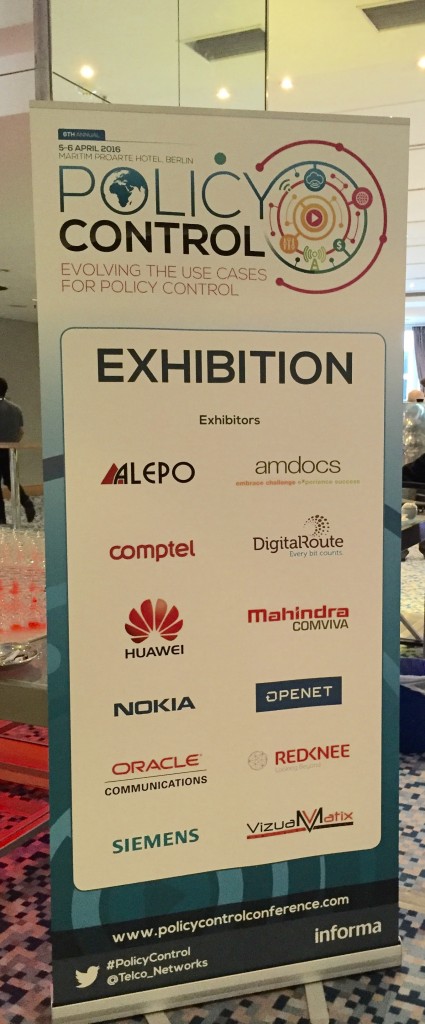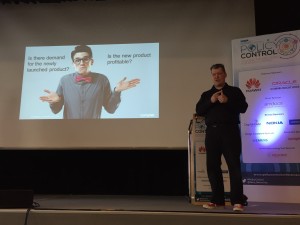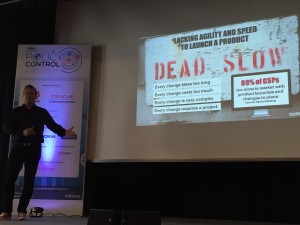Posted: May 6th, 2016 | Author: Steve Hateley | Filed under: Events | Tags: Intelligent Fast Data, Monetisation, NFV, OSS, service orchestration, TM Forum Live! | No Comments »
Technology partnerships are crucial to innovation in telecommunications. At next week’s TM Forum Live! 2016, Comptel will demonstrate the outcome of several recent industry collaborations, all of which are designed to introduce new approaches to digital service delivery, customer engagement, data monetisation and networking.
Comptel is taking part in three distinct partner-driven initiatives, including two TM Forum Catalysts, individually led by Telefonica and Orange; and an IBM-led digital service architecture blueprint. The ultimate objective of each initiative is to open operators’ eyes to new possibilities for infrastructure management, service delivery and offer creation through NFV service orchestration and intelligent fast data management.
Our contributions vary by project. In two of the cases, we’re putting the digital service lifecycle management (DSLM) model that we introduced in Nexterday: Volume II, with our FLOWONE service orchestration technology, managing forward-looking approaches to service delivery. In the third project, we’re supplying expertise and technology in the creation of a new, progressive data monetisation strategy.
Forward-thinking approaches are crucial at a time when customers desire fast, intelligent, personalised offers. Operators are also keen to take advantage of dynamic, intelligent, highly automated and virtualised network environments to speed up innovation, time-to-market and to improve security.
Here’s what you can expect from each partnership, with guidance on how you can learn more and engage with Comptel and our partners at TM Forum Live! 2016.
IBM’s Target Architecture for Cloud-Based Networking
Comptel, IBM and Juniper Networks have developed a new approach to digital service delivery for B2B and B2C customers, incorporating an orchestration and fulfillment architecture that allows operators to better manage end-to-end service lifecycles in complex hybrid networks of virtualised and non-virtualised services.
The architecture is based on our DSLM proposition, which you can read more about in a recent blog from our CTO Simon Osborne. The end-game is a network that’s able to automatically and dynamically deploy network capabilities and agile services in a way that gives customers automated, self-service digital service purchasing and delivery.
To learn more, visit the IBM booth at TM Forum Live!
Open Source NFV Service Orchestration and Lifecycle Management Catalyst with Telefonica
Comptel is also participating in two TM Forum Catalysts, which are proof-of-concept initiatives that encourage technology partnerships in the name of industry innovation.
The first is the NFV Service Orchestration and Lifecycle Management based on Open Source MANO Catalyst – sponsored by Telefonica. Along with Indra and Etiya, the initiative centres on Open Source MANO (OSM), an ETSI project to develop an open source stack for NFV management and orchestration, demonstrated here within a hybrid network environment.
DSLM also plays a crucial role in this Catalyst, as does our FLOWONE V service orchestration solution. The aim is to test the OSM software stack in a practical context and analyse how it needs to evolve to be production-ready.
To learn more about this Catalyst, join Telefonica and Comptel for our theatre session on Tuesday, May 11, 14:30-14:50 at the Catalyst Theatre.
Orange’s Catalyst on a Mobile Sponsored Data Business Model
Finally, Comptel will take part in an Orange-championed Catalyst, “New Business Models with Mobile Sponsored Data,” which also includes partners Salesforce and CloudSense, plus Sigma Systems and DataMi. We’ve contributed our Intelligent Fast Data technology and capabilities to illustrate how enterprises can sponsor mobile customer data usage as a way to incentivise the use of enterprise digital services, increase data engagement, collect usage data and apply policy control.
To learn more about this Catalyst, attend our session titled “New Business Models with Mobile Sponsored Data” at the Catalyst Theatre on Wednesday, May 12, 13:40-14:00.
Comptel is proud to partner with each of these technology leaders in collaborative efforts to introduce new solutions to communications. Whether it’s by improving digital service delivery through new infrastructure models, further developing OSM, or enhancing customer engagement through the creation of new business models, we’re excited to pioneer digital transformation. We can’t wait to share our progress with attendees at TM Forum Live! 2016.
Visit TM Forum’s Catalyst Zone to see these Catalyst demonstrates in action. To arrange a meeting with Comptel at TM Forum Live! 2016, email [email protected]
Learn more about the orchestration capabilities of Comptel’s FLOWONE and download a copy of the Comptel and Heavy Reading research report, “Digital Service Lifecycle Management: How Communications Service Providers Can Play a Successful Role in the Digital Economy.”
You can also learn more about how Comptel is enables operators and global enterprises to act on Intelligent Fast Data in our recent Intelligent Data webinar.
Posted: April 19th, 2016 | Author: Malla Poikela | Filed under: Events | Tags: Monetisation, policy control | No Comments »
 Policy control cannot be seen as a standalone function any longer. It needs to be combined with charging and predictive analytics to give customers the best, most contextual and personalised service experience. At the same time, effective policy and charging control also gives operators the flexible and agile tools they need to monetise data services. That was one big takeaway from the Policy Control Conference 2016, which bills itself as the world’s only event exclusively dedicated to the policy control market.
Policy control cannot be seen as a standalone function any longer. It needs to be combined with charging and predictive analytics to give customers the best, most contextual and personalised service experience. At the same time, effective policy and charging control also gives operators the flexible and agile tools they need to monetise data services. That was one big takeaway from the Policy Control Conference 2016, which bills itself as the world’s only event exclusively dedicated to the policy control market.
Nearly 200 policy control enthusiasts from 80 organisations gathered at Berlin’s Maritim proArte hotel from 5-6 April to learn about the latest and greatest developments in the field of policy control. The entire policy control ecosystem was represented, with scheduled presentations from solution vendors, operators and industry analysts. Executive speed networking, operator-hosted lunches, analyst breakfast roundtable briefings and operator and vendor dinner also offered plenty of opportunity for interaction.
Comptel was in attendance as a sponsor, and we also hosted “The Seven Deadly Sins of Policy Control,” a session with our VP MONETIZER Simo Isomäki and our VP Solution Architecture Martin Vieth. We highlighted the defective, broken aspects of policy control that needed to be corrected as operators evolve toward a modernised and future-proof policy environment. At the event, attendees heard how operators are addressing challenges like time to market, increasing customer experience demands and the introduction of virtualised functions into the network through innovation policy control management. Here are several big takeaways from the event.
Complexity Slows the Speed of Innovation
Network agility is crucial to delivering the flexibility operators need to achieve a higher speed of service creation, which is a valuable asset at a time when monetisation opportunities crop up at a moment’s notice. However, overly complex telco networks slow everything down, making it difficult or in some cases impossible for operators to configure and launch new services fast enough to attract customers at their peak moment of interest.
Simo and Martin explained that the blame lies with complex and scattered network architecture and management, which kills innovation. As a result, many operators are “dead slow” – 69 per cent of CSPs say launching a new product or changing a product takes too long, according to Heavy Reading. The right environment and toolset could speed things up by giving operators a single view to create and change products and allow for service creation experimentation. Operators should strive to innovate when it comes to service pricing, add-on apps, data bundle configuration, delivery speed and more to appeal to digitally savvy customers.
 NFV and Policy Control
NFV and Policy Control
Network functions virtualisation (NFV) is, naturally, one key area of innovation affecting policy control. PCRF is often one of the first network functions to be virtualised as operators seek to respond quickly to changing market conditions.
Many telcos in attendance acknowledged the benefits of NFV, including its ability to drive a 95 per cent improvement in service cycles, outweighed the potential challenges of implementation. Presenters argued that policy control and analytics should be tightly integrated with network and service orchestration, delivering service and customer awareness to the NFV and SDN network.
At the same time, the Comptel presentation emphasised simplicity above all in NFV implementations. Operators are striving towards NFV – one said “If you don’t do NFV, you’ll be left behind”. In our session, Simo and Martin advised a hybrid approach in which brand-new NFV infrastructure and legacy environments work in cooperation to maintain simplicity.
Analytics Enables Better Service Experience
Another major theme at the show involved the central role customer experience should play in policy and charging control management decisions. For example, moving away from the idea of standalone policy control and toward a vision for natively combined policy control, charging, predictive analytics and real-time business reporting helps operators deliver a better and more targeted end-to-end service experience.
One operator described how they currently analyse customer usage behaviour and patterns with a Big Data cognitive learning analytics platform. Using that data, they can guide their policy engine for example to offer the best service with the most attractive apps to customers. Predictive analytics also informs service testing, so that operators can test and affirm a new services’ success before launching it publicly.
 The Customer is at the Centre of Service Experience
The Customer is at the Centre of Service Experience
Forward-looking service creation puts the customer at the centre by selling services the way buyers want. As Fredrik Jungermann explained at Nexterday North 2015, customers buy data by the bundle today only because that’s the way operators choose to sell data, but that doesn’t mean it’s the only way or the perfect way to sell data. Rather than simply selling data on a small, medium, large or extra-large model, Simo and Martin advocated a model where data is flexibly bundled with attractive over-the-top (OTT) content services to appeal to the customer’s preference.
Additionally, there were discussions around the importance of offering consistent mobile service experience no matter the customer’s location. Presenters argued that there is value in policies being access-neutral whether a customer is on fixed internet, mobile data or a Wi-Fi network.
Similarly, operators could change the way the allocate bandwidth per application to improve service experience. Twitter and Netflix, for example, don’t need the same bandwidth speeds to run successfully, but that is currently how those apps are supported by many internet service providers. Why not flexibly support apps with an appropriate level of bandwidth, reserving the best speeds for live streaming videos?
Ultimately, that’s how operators and the industry need to think about policy control moving forward. The customer should always be at the centre of any major innovation in the network or otherwise, so an evolution in policy and charging control should likewise focus on improving the customer experience. Since complexity is the enemy of innovation, operators will need to only consider transformation that can make things work more simply and quickly.
Learn more about the tools how to monetise more in less time: Download our whitepaper about the MONETIZER™ or register to our MONETIZER™ webinar or click to read about our MONETIZER™. To keep up on the latest news and discussion topics, please join our Magazine and Reader Community in nexterday.org.
Posted: December 15th, 2015 | Author: Simo Isomaki | Filed under: Industry Insights | Tags: Monetisation, VoLTE | No Comments »
When we wrote about the state of the Voice over LTE (VoLTE) market little while ago, we discussed the obstacles that operators could face when deploying the emerging technology. Although the number of VoLTE projects is growing, it’s worth asking the question: just how disruptive will high-definition voice be as a revenue generator?
The answer? It’s hard to believe that VoLTE will be the killer app that significantly increases operator revenue.
That’s because, from the consumer perspective, it won’t seem like much has changed at all. They will still open the voice “app” on their phone to make a call. Yes, there will be a handful of new features, including the ability to switch from an audio call to a video call, and, of course, superior voice quality. But, these aren’t features consumers would necessarily want to pay extra for, and if operators charge the same for VoLTE as they do traditional calls, the revenue point is moot.
However, that doesn’t invalidate VoLTE’s value as a service differentiator. The key to unlocking new sources of revenue from VoLTE will be in adopting a flexible monetisation approach.
That will require operators to think beyond pre-configured VoLTE service packages. Operators might opt for these because it seems to be an easier way to try an emerging technology, but they put themselves at a disadvantage.
When the vendor controls everything about how VoLTE is configured, you can only sell the service the way the vendor has dictated. You aren’t able to customise the way you implement and monetise VoLTE based on local market factors. It can often take you longer to implement the technology in the first place or change your implementation based on new developments. Overall, this means operators are slower, less proactive and have a harder time meeting customers’ unique needs.
It also limits other benefits of a VoLTE deployment including efficiency in the network, the ability to reform the cellular spectrum and improved cost competitiveness. Those will all save operators money, but they don’t add up to dramatically improved revenue. It’s better if operators have the power to customise VoLTE implementation and monetisation.
Perhaps you want to bundle VoLTE and Voice over Wi-Fi (VoWiFi) services together. Maybe you don’t. Maybe you want to give VoLTE away to enterprise customers free of charge, bundling it as part of a larger corporate offering. Or maybe you’ve thought of an entirely new way to monetise the new technology that no one else has considered.
Ultimately, it should be up to you, not your vendor, to find the right way forward. Configurability in service monetisation is a key factor in achieving business elasticity, a concept we’ve discussed recently. For operators to be elastic – which defines their ability to change, upgrade, improve and react quickly to dynamic market changes – they will need to ensure their VoLTE capabilities are free from the fixed limitations of traditional vendor engagements. Elasticity is a key capability that requires fast, tailored, highly responsive customer service.
VoLTE is not a silver bullet, but that doesn’t mean operators should leave money on the table. Opt for a vendor that will let you configure VoLTE the way you want, and then start thinking of creative new ways to monetise it.
If you missed it, read the first blog post in this series, where we evaluated VoLTE pros and cons. And keep an eye out for our next piece, where we’ll cover the future of VoLTE and where we think this emerging technology will fit in the broader world of digital and communications services. If you want to control your own destiny and deploy VoLTE features the way you want it, the MONETIZER™ is there for you.
Posted: February 2nd, 2015 | Author: Malla Poikela | Filed under: Industry Insights | Tags: buying experience, charging, Generation Cloud, Monetisation, Operation Nexterday, PCRF, policy control | 2 Comments »
The always-on, “Generation Cloud” is quickly developing new habits when it comes to data usage. Not only do these digital natives consume more, they use several devices – often at the same time – to access the content and applications they want. They expect it to be available whenever, wherever and on any device – even their car, house or watch might be connected to the Internet.
Fast and omni-device access to data enables people to change the way they work, interact with their friends and families, shop, learn and much more. It helps them improve their quality of life. For these reasons, customers are willing to pay for their data usage. And many of them are willing to pay a premium to enjoy their digital moments faster and with better service quality.
Consumers’ preferred data service buying experience is developing in tandem. “Generation Cloud” expects personalised, in-the-moment offers and a seamless purchase process. When provided, customers are willing to spend more.
Communications service providers (CSPs) need to act now and evolve their marketing and selling to keep in line with how customers are buying today and in the future. By adopting an “Operation Nexterday” approach, operators can anticipate consumers’ needs and maximise their interactions, monetising more in less time than ever before.
Sell something you don’t own – but take control
Today, CSPs’ bundling of third-party content and applications has become almost commonplace; it’s no longer seen as “special.” Selling something you don’t actually own doesn’t mean that you are out of control, though. Tighter integration between CSPs and Over-the-Top (OTT) players, as well as policy control and charging can help you optimise the buying experience and differentiate.
Partnered content or services, for example, are often loosely attached to CSPs’ offers. It might be a discount code passed onto a customer for use when he or she – separately – signs up for Spotify or Netflix. But consider the possibilities if the buying experience and the policy rules for handling and charging for this specific data traffic for this specific customer were tightly integrated.
Complexity is mounting – but…
Tighter integration and context-aware personalisation increase the complexity in policy and charging control. Dynamic changes in user behaviour and the competitive landscape will only add to this complexity, as will the Internet of Things (IoT) and voice over LTE (VoLTE).
Just think about the ultimate offer that contains all of the required ingredients such as subscription, rating, Quality of Service (QoS), monthly fees, cost control, roaming data package, advice of charge, applications, VoLTE and much more, all in one bundle – that’s a lot to deal with all at once and to cater to a very diverse audience.
Traditional PCRF and charging do not offer the sufficient flexibility and agility; thus, the legacy setup with yesterday’s offer design tools lack the ability to manage complexity efficiently. The complexity that arises is also the result of network upgrades, adding new capabilities and new elements like IMS and EPC. Due to the ‘patchwork’ architecture, every change takes too much time.
One size fits one
The era of one-size-fits-all campaigns is over. Rather, launching a number of agile, micro-level, long-tail campaigns that are tailored for smaller customer segments is the way forward if CSPs are going to profit. This is because offers, including the technology to enable them like policy and balance management rules and rating, have become much more complex.
Policy and charging rules are no longer stand-alone entities; they are blended. And on top, they will need to seamlessly integrate with predictive analytics and machine learning, to see and tap into patterns that the human mind just can’t. CSPs can then predict customer behaviour. They can predict network quality or outages. They can determine the best offer for each unique customer situation. And their systems’ learning never stops.
… but there’s more to monetise in customers’ digital moments
Data usage monetisation is a huge revenue opportunity, requiring maximum speed and flexibility for the offer design to be successful. System alignment and a contextual understanding of “Generation Cloud” customers are just as vital. In order to capitalise on this, CSPs should natively combine siloed policy control and charging functions. On top of this, they must add historical and anticipated insights on their individual customers and network traffic trends. Operators that can combine these will propel their business to “Nexterday” and be a fierce competitor in the post-digital era.
Comptel will be attending Mobile World Congress, taking place 2-5 March 2015 in Barcelona, Spain. Interested in continuing this discussion on perfecting and monetising your customers’ digital moments? Email [email protected] to set up a meeting, or visit us in Hall 5, Stand #5G40 to pick up a book about “Operation Nexterday.”
Posted: July 24th, 2012 | Author: Ulla Koivukoski | Filed under: Industry Insights | Tags: 4G, analytics, bandwidth, CIQ4T, Comptel, contextual intelligence, customer experience, Heavy Reading, Making Data Beautiful, Monetisation, Podcast, Quality of Experience | 1 Comment »
In part one of our two part series, Heavy Reading analysts Ari Banerjee and Sarah Wallace discussed contextual intelligence for telecoms (CIQ4T) and how this type of approach, which provides advanced analytical insights for a holistic customer view, can improve engagement and elevate the customer experience.
Now, in the second and final installment, Ari and Sarah delve a bit deeper into what this actually means for service providers and explore some real-life examples of putting CIQ4T to work, such as monetisation, network resource optimisation and dynamic profiling with advanced analytics.
As I mentioned in one of my earlier blog posts, the telecommunications industry needs to increasingly predict what is important to customers rather than simply being reactive – and analytics plays a key role in helping to achieve this. Ultimately, turning all of this data into actionable information helps to bring people close together and furthers our goal of making data beautiful.
Like last week, you can listen to the full podcast of the conversation here or read the highlights below.
Ari Banerjee: Can you talk a little bit about the use cases that Comptel is addressing today that are more customer-facing?
Sarah Wallace: One of the first use cases is obvious but also very important, and that’s monetisation. This includes upselling to the customer, offering them something that might be triggered through some type of complaint, or offering them a new service. Another aspect of this is cross-selling – identifying subscribers and offering something they don’t necessarily need but that fits their usage pattern. So, for instance, service providers could offer a device with its own hot spot to a customer who may travel a lot.
Then, of course, there’s the aspect of new customer acquisition when it comes to monetisation. This entails identifying influencers in the network that might have a lot of off net relationships and making them an offer that will compel them to spread it virally – subsequently acquiring new subscribers.
Ari Banerjee: Beyond that, there’s the whole element of network resource optimisation. As we all know, when it comes to wireless, bandwidth management and resource management become extremely critical. Looking at the evolving wireless industry and all of its networks, 4G rollout is happening almost everywhere across the globe with LTE as the preferred route that most operators have taken.
With this comes another element of how to use spectrum, bandwidth and network resources better – especially when we look at services that are becoming more popular to enterprises or to consumers. These are really services that are low latency – those that revolve around video content and media. How do you provide expected quality of experience? All of that, again, needs advanced analytics or use of CIQ4T in a much broader way. Therefore, an OSS/BSS vendor already in the network can provide a lot more value additions for service providers.
One of the things that we are seeing operators challenged in is around cell-site optimisations. As we know, 4G networks are challenging because of things like traffic load balancing, handing over traffic between cells, determining where to put small cells – all of these need much more contextual information. So if OSS information is joined with contextual information, such as user experience, location and so forth, there’s a typical pattern of user-behaviour that can be mapped out.
Analytics can show that reducing power of one cell in favor of another cell might improve the overall network. Also, it can provide intelligent analysis around experience of a small set of high value customers who are typically using demanding services at a set time during the day, and how this can be handled in a better way based on load balancing across different parts of the network.
Subscriber-centric wireless offload – this becomes very important – and any operators who are providing 4G services are talking about wireless offload. This is because you cannot keep a subscriber on 4G continuously, it must instead be offloaded. Can this be done more intelligently using analytics? Can decisions be made based on the profitability of the customer lifetime value? Is there an SLA attached to the customer? Are they part of an enterprise contract? All of these different dimensions come through and are brought together via OSS/BSS systems and then intelligent decisions can be made based on which subscriber to offload. Again, use of CIQ4T and advanced analytics plays a major role here.
Service control based on subscriber profiles is another area that we think CIQ4T makes a lot of sense. By augmenting network data with subscriber data, utilising behavioural patterns, matching subscriber preferences and so forth, services can be tailored according to different users on the same subscriber account. So, for example, giving a company’s directors priority service compared to other employees, or managing a parent’s business applications in a different way than the entertainment applications used by their children.
So again, advanced analytics can also drive policies, which can drive service elements in the network and these can be programmed into things like policy servers for enforcement throughout the network in a much more soft-ticketed fashion.
Sarah Wallace: Some other use cases in addition to that include real-time churn prevention. This means being able to examine behaviours in subscribers who are obviously going to churn. Various elements to observe are multi-SIM prediction, rotational churn, and even churn location (do they reside in an area that has a propensity for high churn?)
Another use case is the concept of dynamic profiling with advanced analytics. This entails examining characteristics such as their usage, interests, location, socio-economic class, influence in their network (SNA), overall propensity to churn and their relationship to off net users.
Then, of course, there’s SNA which is a sub-set of advanced analytics. It’s really just looking at social networks in the sense of relationships – looking at family, friends and co-workers – and seeing what kind of influence the subscriber has in their sphere.
The last use case is advanced offer management – enabling service providers to confirm which promotions and service bundles are successful to offer including loyalty points, event and rule-based promotions, traffic-based promotions and management capability based on data subscriber network usage.
Personally, it makes me happy to think that Comptel’s software can be – and is – a part of the lives of so many people. And as consumers have different expectations for quality of experience, one of my personal favourite use cases is defining how to provide the experience that is right for each customer. Which use case do you find most appealing for CIQ4T?



 Policy control cannot be seen as a standalone function any longer. It needs to be combined with charging and predictive analytics to give customers the best, most contextual and personalised service experience. At the same time, effective policy and charging control also gives operators the flexible and agile tools they need to monetise data services. That was one big takeaway from the
Policy control cannot be seen as a standalone function any longer. It needs to be combined with charging and predictive analytics to give customers the best, most contextual and personalised service experience. At the same time, effective policy and charging control also gives operators the flexible and agile tools they need to monetise data services. That was one big takeaway from the  NFV and Policy Control
NFV and Policy Control





